© elfruler 2023
Reproduction in birds involves mostly the same or analogous hormones as in humans and other mammals, but the processes involved are affected by some significant distinctions between birds and humans, including:
-
- Birds are oviparous (Latin ovi = egg + parus = producing), as opposed to viviparous (Latin vivus = living + parus = producing). They lay hard-shelled eggs with the barely developed embryos encased inside, along with all the nutrients the embryos will need while they develop.
- A bird’s Reproduction season generally recurs every year (or two in some species). It is the central stage in a Life History that in many, if not most, species is repeated annually throughout a bird’s lifetime. In Bald Eagles Reproduction can occupy from 8 to 10 or 11 months of the year.
- Because birds are wild, feathered, flying creatures, for most species the gonads are mature and active only during the Reproduction stage of the annual Life History. The “down” time for the reproductive system is an adaptation that prevents breeding at an inopportune time of year, and it enables the bird’s body to allocate its energy resources to Molt and post-breeding Movements. After each annual breeding the gonads regress to a minuscule and unproductive physiological state and must regrow every year to maturity (gonadal recrudescence) for the next breeding season.
- The hormonal and other physiological (endogenous) changes that birds undergo and the behaviors they engage in during Reproduction are triggered by exogenous cues from the immediate environment, especially changes in the photoperiod. Physiology and behavior also can be affected by supplementary external factors such as extreme weather, social interactions, health of the pair, food availability, territorial disputes, and human disturbance. (Discussion of photoperiodism and how and when the Reproductive stage begins across North America is found here.)
Everyone knows about the so-called sex hormones produced by the Gonads (the Ovary, of which most female birds have only the one on the left, and the paired Testes) – Estrogens, Testosterone, Progesterone. Less familiar are the hormones that trigger those gonadal hormones, secreted from the Hypothalamus, a region of the brain, and from the two lobes of the Pituitary Gland that are below and connected to the Hypothalamus. (Go here for details on the Endocrine System and Hormones.) The Hypothalamus serves as the body’s bridge between the exogenous environment (light and other cues) and the endogenous physiological systems. It kickstarts the Reproductive process. The Pituitary Gland, often called the “master gland,” is in charge of sorting the multifarious signals it receives from the Hypothalamus and other organs and glands, as well as some exogenous cues, and determining what hormones downstream need to be activated and when. Among the hormones it produces are gonadotropins (= hormones that act on the gonads). The Posterior lobe of the Pituitary Gland does not produce hormones but receives and stores hormones from the Hypothalamus.
These structures and the hormones they produce are at the core of the Reproductive process, and researchers group them together as the Hypothalamo-Pituitary-Gonadal (HPG) Axis. Here is a schematic flowchart (not to scale) of what the HPG Axis looks like in birds (Orange boxes represent glands and organs, blue boxes represent hormones, green arrows represent positive effects, and red arrows represent negative effects. Actions of the hormones and the timing of their release are described in more detail below. Click on the image for an enlarged view): 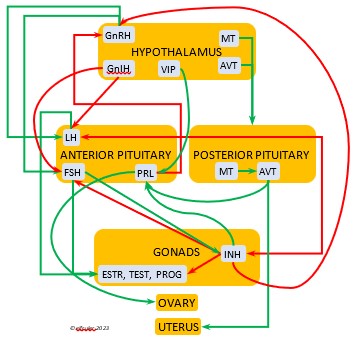
HYPOTHALAMUS
GnRH = Gonadotropin-Releasing Hormone
VIP = Vasoactive Intestinal Peptide
MT = Mesotocin, stored in the Posterior Pituitary for later
release
AVT = Arginine Vasotocin, stored in the Posterior Pituitary
for later release
GnIH = Gonadotropin-Inhibiting Hormone
ANTERIOR PITUITARY GLAND
LH = Luteinizing Hormone, a gonadotropin
FSH = Follicle-Stimulating Hormone, a gonadotropin
PRL = Prolactin
GONADS (Testes and Ovary)
ESTR = Estrogens
TEST = Testosterone
PROG = Progesterone
INH = Inhibin
Other glands also produce hormones that play a role in Reproduction, including the Thyroid, which secretes T3 (= Triiodothyronine) and T4 (= Thyroxine), the Adrenal Cortex which secretes CORT (= Corticosterone), and the Adrenal Medulla which produces EPI (= Epinephrine) and NE (= Norepinephrine).
Biologists have established a broad outline of three phases of the Reproduction cycle in birds and the behaviors observed in each phase (adapted from Wingfield 1999; Bentley et al. 2007):
- Preparation, including territory establishment, pair bonding, the beginning of gonadal recrudescence, sperm production, and yolk deposition in the ovarian follicles.
- Maturity, which can be divided into two sub-phases:
- Sexual Sub-phase, including nest finalizing, ovulation and fertilization, and oviposition
- Parental Sub-phase, including incubating eggs and caring for chicks
- Termination, including juvenile fledges and dispersal, and adult movements
Here is how these phases fit into the full annual Life History of Bald Eagles (click on the image for an enlarged view):
The duration of each phase can depend on latitude, stability of the pair, territorial challenges, weather, human disturbance, etc. Details and sometimes the sequence of events can differ from one avian species to another, as well as among individuals within a species. Hormones are released in sequence as these phases progress. Here is how the Reproduction phases play out for Bald Eagles:
PREPARATION/DEVELOPMENT PHASE
This is a critical phase of Reproduction, and it can extend from 8-16 weeks for Bald Eagles. Gonadal recrudescence is a slow process, and to maintain its progress male and female Bald Eagles must engage in preparatory behaviors of claiming their territory and pair bonding, including flying and roosting together, sharing food, vocalizing, and nest-building. The social interactions between the pair are important factors in stimulating hormonal secretions and establishing the delicate balance between them that enables their reproductive systems to develop synchronously, eggs to be fertilized, and parental care to be mutual and effective.
The length of this stage depends on whether the bond is already established and an existing nest is available. New pairs may begin with one adult from a previous season who is courted by one or more potential mates. Sometimes an entirely new male and female take over a nest. A new nest can be built within a week or two if necessary, but hormonal synchrony still must develop over time.
These bonding behaviors reinforce the daily photoperiod changes that photoreceptors in the Hypothalamus perceive, telling the pair that it is the time of year in their Life History to enter the Preparation phase of Reproduction. The Hypothalamus in each bird then activates a gradual and steady increase of hormonal secretions, as this flowchart shows. (Faded arrows indicate hormonal actions that are absent or minimal during this phase. Click on the image for an enlarged view.)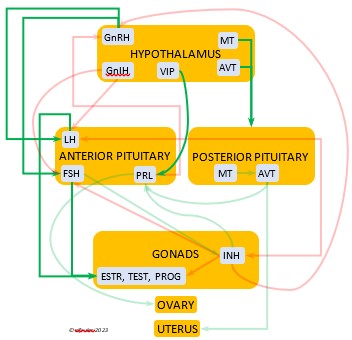
Gonadal recrudescence
GnRH begins the hormonal cascade by triggering the release of the gonadotropins LH and FSH, and these respond by stimulating production of the gonadal hormones ESTR, TEST, and PROG and their release to the oviduct and the male’s sperm duct (the vas deferens). Together, these gradual secretions begin the long process of gonadal recrudescence and stimulate territory establishment and pair-bonding activities.
Copulation becomes more frequent as the phase progresses, which brings about a rise in circulating levels of Thyroid hormones T3 and T4 (not depicted in the flowchart), which play a role in spurring gonadal growth and the production of sperm and ova.
The Hypothalamus secretes the hormones MT and AVT to the Posterior Pituitary to be stored for later release.
Spermatogenesis, yolk deposition, and ovum development
After a few weeks, the Gonads have reached a certain state of development and LH and FSH stimulate the Testes to begin producing sperm (spermatogenesis), and an ovum to begin developing in the Ovary. A yolk (with lipids and proteins for the future embryo) begins to form in the first ovarian follicle in line (F1). LH secretion in the male reaches a peak near the end of the Preparation phase, and shortly thereafter in the female.
Brood patch
GnRH secretion peaks toward the end of the Preparation phase, while secretion of VIP begins to increase, stimulating production of PRL, which along with ESTR and PROG initiates development of brood patches.
MATURITY/NESTING PHASE: SEXUAL SUB-PHASE
This is the briefest but most intense period of the breeding cycle. Reproductive hormones become fully activated. Over the course of only 3-4 weeks, parents finalize the nest, copulation increases dramatically, brood patches near completion, eggs are ovulated and fertilized, eggshell is laid down in the uterus, embryonic development accelerates, and eggs are laid (oviposition). Click on the image for an enlarged view.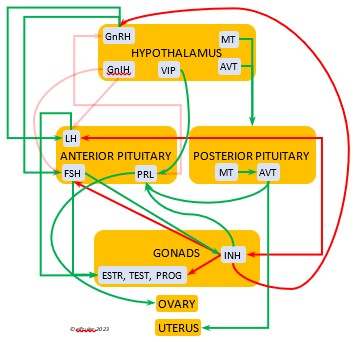
Gonadal maturation
GnRH, LH, FSH, and gonadal hormones ramp up significantly and rapidly, bringing the Gonads to maturity.
FSH peaks about halfway through this sub-phase. It encourages nest completion, induces increased spermatogenesis and final yolk deposition in the ovarian follicle (F1). FSH remains high until all eggs are laid.
LH also helps stimulate increased spermatogenesis. It rises a little more slowly in the female and boosts ESTR and TEST levels in the Ovary, stimulating yolk deposition in the ovarian follicle (F1) and development of the ovum.
Brood patch
VIP secretion increases, further stimulating release of PRL, which rises dramatically as ovulation approaches, working with ESTR and PROG to finalize development of brood patches. De-feathering is nearly complete by the time ovulation occurs, although full vascularization is reached later during the incubation period.
Ovulation, fertilization, and embryonic development
TEST and ESTR peak a few hours before ovulation, then decline gradually to ovulation. Both contribute to inducing sperm production and maturation of F1 in the Ovary, and ESTR prompts production of albumen in the oviduct. ESTR and PROG may play a role in determining the gender of the embryo. ESTR, along with PTH (= Parathyroid Hormone) from the Parathyroid Gland (not depicted in the flowchart), is instrumental in increasing the concentration of calcium in the Uterus for eggshell production.
LH inhibits production of INH until ova are approaching maturity, when INH assumes an essential role in ovulation. INH complements the action of FSH so that only one egg ovulates at a time. FSH induces maturation of F1 while stimulating INH, which inhibits development of the less developed follicles (F2, F3, etc.). After F1 is ovulated it is fertilized quickly, and the next follicle in line becomes the target of FSH while INH shifts its inhibitory action to the follicles behind it. This ebb and flow repeats for each ovulation. INH then helps suppress production of GnRH, LH, and FSH to bring egg production and ovulation to an end.
PROG increases gradually and spikes just before ovulation. Immediately after an egg is ovulated, PROG stimulates stored sperm to move up the oviduct for fertilization.
PROG and ESTR send positive feedback to GnRH, LH, and FSH. LH surges just before ovulation and remains high until all eggs are laid, then declines quickly.
Thyroid hormones (not depicted in the flowchart) are critical in the female, who must produce enough to supply her own needs and those of the developing embryo. If her levels are insufficient, she may not be able to lay eggs, or the embryos may not develop properly. (McNabb & Darras 2015, 541) T4, which also contributes to gonadal recrudescence, peaks early during the Sexual Sub-phase and then is suppressed by gonadal hormones.
Oviposition
MT, with assistance from ESTR and PROG, dispatches AVT to the Uterus to induce uterine contractions. PROG begins to decrease slowly after ovulation. The ovulation and oviposition cycle of Bald Eagles repeats every 3 or 4 days until all eggs of the clutch have been laid.
Gonadal regression
GnIH (the inhibiting hormone) secretion begins after ovulation, helping suppress LH and FSH and leading to a decrease in gonadal hormones and the beginning of gonadal regression.
The pace of PRL secretion and its amplitude pick up when ovulation comes to an end. It is further stimulated by VIP and AVT, inhibiting LH and FSH and further growth of the Gonads after a clutch is complete.
GnRH begins to decline slowly after the last oviposition, while LH and FSH decrease more rapidly, contributing to gonadal regression.
MATURITY/NESTING PHASE: PARENTAL SUB-PHASE
The decline in reproductive hormones results in less intense sexual interaction between male and female and encourages “broodiness” as researchers often describe the parents’ demeanor during this period of unflagging attention to eggs and then chicks. The Parental sub-phase begins with the long period of incubation of about 36-42 days, depending on the number of eggs in the clutch. This period is known by nest cam viewers as the “slow” season when there is little to watch other than eagles taking turns incubating and occasionally bringing sticks and other materials to shore up the nest. Sharp-eyed observers may begin to see stray feathers in the nest, as Molt begins about halfway through incubation. When the eggs hatch, demands on the parents intensify dramatically as they tirelessly feed and protect the growing eaglets from weather and predators until they fledge after about 10-13 weeks. Click on the image for an enlarged view.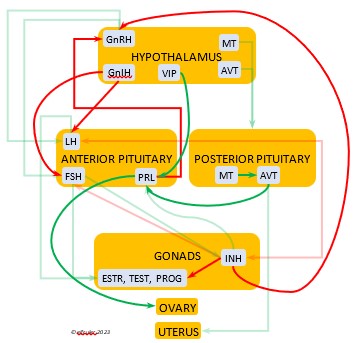
Gonadal regression
GnRH continues its slow decline through incubation, as GnIH continues to rise, inhibiting secretion of LH and FSH, leading to a decrease in gonadal hormones and furthering gonadal regression.
PRL is still stimulated by VIP and AVT and continues to suppress GnRH and gonadal hormones.
Incubation and Molt
PRL is stimulated also by the presence of eggs, inducing incubation behavior. It may also help activate Molt.
ACTH (= Adrenocorticotropic Hormones) from the Anterior Pituitary (not depicted in the flowchart) stimulates secretion of CORT (= Corticosterone) from the Adrenal Cortex (not depicted in the flowchart) peaks, helping induce incubation behavior and depress gonadal hormones. ACTH secretion increases about halfway through incubation and contributes to the suppression of GnRH and gonadal hormones. It helps increase circulating Thyroid hormones T3 and T4 (not depicted in the flowchart) which begin to stimulate feather growth and Molt in the incubating parents.
Brooding eaglets
In Bald Eagles and many other altricial species, PRL remains high through the Parental sub-phase while other hormones begin to decline, maintaining parental behavior and further dampening sexual interactions. PRL tapers off only slightly and may help stimulate Molt.
TERMINATION PHASE
After the juveniles fledge, both eagle parents generally continue to provide food as their young learn flying skills, watch the adults closely for thievery opportunities, and probably pick up pointers about where and how to find food. The phase can be as short as a week (depending, for instance, on whether the parents disperse quickly to areas of better food availability, as they do in the Pacific Northwest), or as long as 7-8 weeks. Gonadal regression is nearly complete. An increase in CORT in the parents as the fledglings disperse helps reduce reproductive hormones to their base levels. Fewer demands on the energies of the adults allow Molt to accelerate (the juveniles retain their first contour feathers for a year), although it can be interrupted during periods of Movement. T4 continues to stimulate feather growth.
TIMING IS EVERYTHING
Behaviors, hormonal secretions, and physiological changes work together, each affecting and reinforcing the others during every phase of the Reproduction stage. Hormones induce endogenous changes such as gonadal recrudescence, as well as activities such as copulation and nest-building. These behaviors in their turn stimulate further hormonal and biological changes in the mate, and so on in a continuous feedback loop. This circularity is key to establishing behavioral and physiological synchrony between female and male, especially during the Preparation phase. A relatively short Preparation phase that might result from disruptive events like severe weather or replacement of a mate may hamper the development of synchrony between the pair, which could result in unequal timing of ovum and sperm production and hence fertilization, or disharmony in parental activities.
The timing and pace of the secretion of reproductive hormones among most avian species are similar, within the bounds of each species’ Life History. Using data and information from many sources, I have created an amalgam schematic diagram of the characteristic reproductive hormone secretions within the framework of a typical 40-week Reproduction stage of a pair of Bald Eagles. (This diagram is not a representation of actual data but depicts an approximation of the rise and fall of each hormone in relation to the others and to events during Reproduction. Some activities are likely to occur within the same time frame, e.g. nest building and copulation. Blue lines represent male secretions, orange lines represent female secretions. Click on the image for an enlarged view.)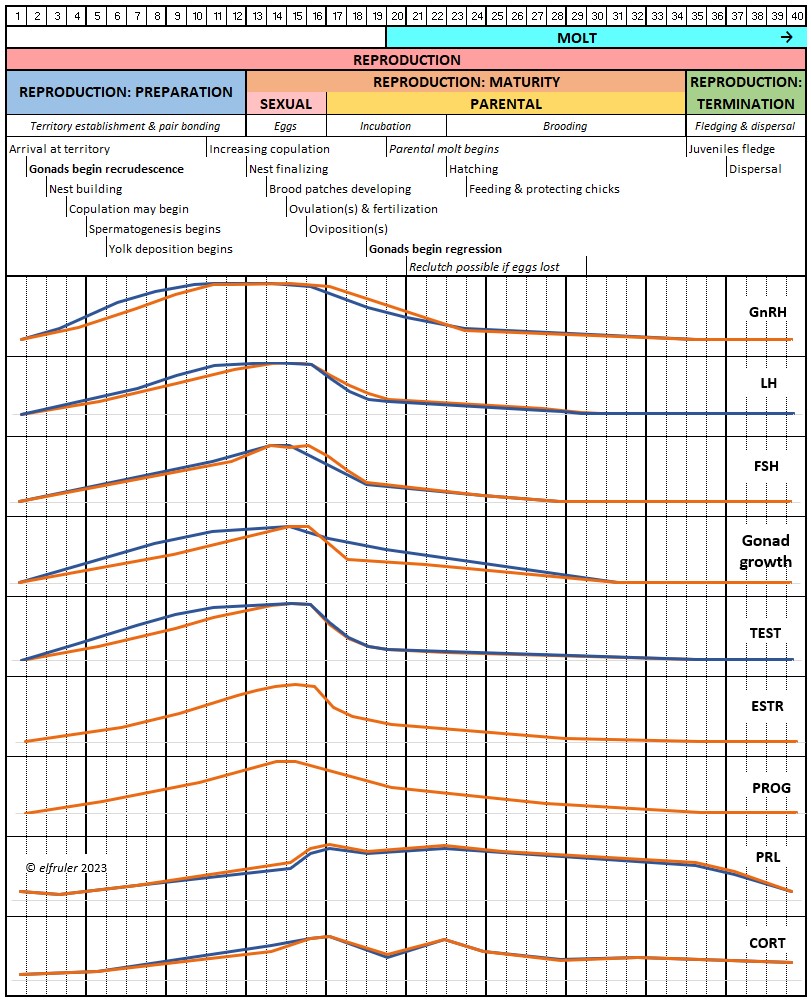
Several things to note:
-
- Secretions of GnRH, LH, FSH, and TEST occur earlier in males (blue lines) than those of females (orange lines), and the Testes develop more rapidly than the Ovary. This means that spermatogenesis occurs much earlier than ovum maturation, which is a more complicated process that does not reach fulfillment until just before ovulation. All the copulation in the world will not result in fertilization until an egg has been ovulated, but it does strengthen the bond between male and female. It also enables a male to implant perhaps millions of sperm in her oviduct for storage. (But it is uncertain how long sperm remain viable after insemination, and by the time an ovum is ready, recent sperm are more vigorous and better able to compete for fertilization rights than older sperm.) The earlier start of males in the Preparation phase is often noted by Bald Eagle nest cam viewers who sometimes see breeding males appear and begin nest-tending sooner than females do.
- Conversely, female secretion of GnRH, LH, and FSH usually remains more elevated later into the Parental sub-phase than in males. If a clutch of eggs (or in rare instances, of chicks) is lost, this elevated level keeps the female at a sufficient state of readiness to recycle her secretions to produce a new clutch of eggs.
- PRL rises dramatically in males and females just before eggs are ovulated, while the reproductive hormones are beginning to decline and gonads are regressing. PRL generally remains at a high level through the parental care period.
- The timing difference between the secretion of PRL and the reproductive hormones is clear in this diagram, with the rise of PRL lagging the others. This is crucial to breeding success. If the biology and behavior of a pair are in step, ovulation and fertilization occur before PRL induces both female and male to share incubation duties. But this harmony is disrupted if one member of a breeding pair is lost and a new adult attempts to establish a bond with the remaining breeder. If this occurs early in the Preparation phase there still may be time for them to achieve synchrony, but it becomes much less likely as the Maturity phase approaches. This is especially so if it is the male that is lost and a new one appears. His gonads may recrudesce quickly and begin producing sperm, but he may have missed out on the pair-bonding activities that are crucial to a pair’s synchrony. Further, the disruption may have caused her reproductive system to shut down, preventing ovulation. Even if she is able to ovulate, and his sperm succeed in fertilizing her eggs, his GnRH, LH, and FSL may still be rising while hers are declining, causing him to persist in sexual behavior while her focus will shift to incubating as her PRL ramps up. She will bear all the burden of caring for the eggs, and probably will need to leave the nest to find her own food. This disconnect is likely to continue until they both abandon the breeding attempt.
- CORT becomes elevated near the time of oviposition, helping depress secretion of reproductive hormones and encourage incubation. It then tapers off but rises again in response to PRL, to aid in preparing the parents for the intense demands of caring for new nestlings.
Any phase of Reproduction can be interrupted by events such as extreme weather, territorial challenges by other eagles, owls, larger hawks, or ospreys, loss of a mate, a nest, or the food supply, or human disturbances. The Hypothalamus responds quickly to serious unexpected disturbances by secreting CRH (= Corticotropin-Releasing Hormone) to the Anterior Pituitary, which sends ACTH to the Adrenal Glands. The Adrenal Cortex immediately releases CORT and the Adrenal Medulla secretes EPI and NE. These hormones quickly suppress secretion of reproductive hormones and induce appropriate responses by the eagles, including suspending breeding behaviors, taking shelter, challenging intruders, or vacating the area. Ovulation may be delayed if the normal LH surge just preceding it does not happen, or the cessation of secretion of AVT to the Uterus may postpone uterine contractions. The reproductive hormones may restart if adverse conditions are not prolonged, and the bonded pair could resume hormonal and behavioral development. If difficult events are prolonged, they may hamper or suppress the cycle of reproductive hormones completely, causing the breeding attempt to fail.

You must be logged in to post a comment.